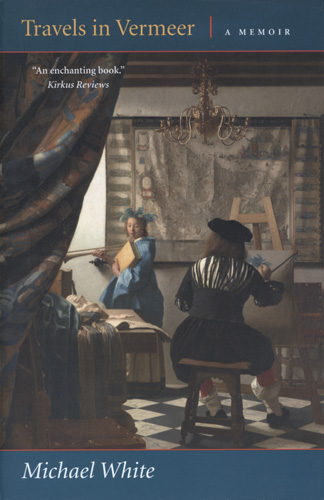Travels in Vermeer
A little bit travelogue, a little bit art history, and a little bit heartbreaking memoir, Michael White’s Travels in Vermeer explores the author’s fascination with the paintings of Johannes Vermeer, a fascination that takes him around Europe and America. Traveling to Amsterdam, The Hague, Delft, Washington D.C., New York, and London in the course of a year—while at the same time dealing with a painful divorce and custody battle, remembering the difficulties of his childhood and the alcoholism of his early adulthood, trying to get back into the dating scene, and remembering the brief, passionate romance with his first wife, who died of cancer—White gives long meditations on Vermeer’s paintings in lyric detail, becoming an intense eye through which we the readers also get to see them. A little bit travelogue, a little bit art history, and a little bit heartbreaking memoir, Michael White’s Travels in Vermeer explores the author’s fascination with the paintings of Johannes Vermeer, a fascination that takes him around Europe and America. Traveling to Amsterdam, The Hague, Delft, Washington D.C., New York, and London in the course of a year—while at the same time dealing with a painful divorce and custody battle, remembering the difficulties of his childhood and the alcoholism of his early adulthood, trying to get back into the dating scene, and remembering the brief, passionate romance with his first wife, who died of cancer—White gives long meditations on Vermeer’s paintings in lyric detail, becoming an intense eye through which we the readers also get to see them.
The book hinges on those moments of meditation and trance. We, with White, are caught in the paintings, many of which depict a woman in the midst of some mundane scene, but momentarily distracted, possibly by someone outside the frame. But, as White points out, it is easy to get caught up in that distraction as a viewer of the Vermeer. They draw the readers in, especially in the cool, steady gazes of the women who lookout of the paintings. Their eyes become fixing, bringing the viewer—especially Michael White—into their lives. Though he did not originally go to Amsterdam to see Vermeer’s paintings—only going as a way to escape some of the pain left for him back home in Pennsylvania—when he sees several paintings in the Rijksmuseum, he becomes entranced for the first time.
Suddenly, I understand: Vermeer’s hushed clarity addresses me, is for me as I stand here now. What I’ve been going through, what I’ve tried to deal with in my divorce, is total loss. I thought I knew about all that when my first wife, Jackie, died of cancer—but this time, I’d lost faith. It isn’t just that I don’t believe in love, I’m not sure I believe in anything. But, looking at these radiant canvases—unreachable yet familiar—reminds me. [ . . . ] It’s as if these visions are here to startle me to my senses by showing me recovered images from a former life.
The language of Michael White’s prose is, like that of his poetry: easy and accessible. You feel that he is not trying to impress anyone or make any grand claims about life. It is his life, only, that he is concerned with, and so we are invited in without any pressure to grieve or exult with him. We are, like he is to Vermeer, just observers, welcome to become entranced or, like the many other museum goers who glance and leave, to move on. The simple language and effortless narrative structure makes the book a quick read, engrossing even in the slowness of its brushstrokes. The composed frankness with which he tells of his travels and troubles comes across merely as dispassionate thoughts. The evenness of that tone becomes the negative space on which certain emotional colors are painted. He describes seeing The Girl With the Pearl Earring:
Love: How could I have forgotten that feeling? The instantaneous, passionate gaze that comprehends me, beyond accusation or forgiveness. The lovely sympathy in her hazel irises, the lush eroticism of her lips, her mouth. She is the clapper, I am the bell, and she rings through my whole body.
That quote above may seem sentimental, and perhaps it is, but it is honestly written. The beauty of White’s memoir is in just such moments, when, suspecting that he cannot love, he feels it through a painting.





